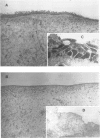Abstract
Nasal polyposis is a chronic inflammatory condition of the upper airways characterized by infiltration of activated inflammatory cells, including mast cells, both in the epithelium and in the stroma. The aim of this work was to study human mast cells derived from two different anatomical sites within the same nasal polyp tissue. To this end, we isolated two distinct mast cell populations, one from the epithelial and the other from the stromal layers of individual human nasal polyp tissues. We examined the mediator content of the two mast cell populations and found that stromal mast cells had a significantly higher content of tryptase compared with the epithelial mast cells from the same tissue. In addition, mast cells from the stromal compartment, but not those from the epithelium, released a significant amount of histamine after anti-IgE stimulation. By contrast, both populations released over 50% of the total histamine after non-specific stimuli (A23187 10(-6) M). The content of mediators and the response to immunological activation were not significantly altered in patients receiving topical steroid therapy. It remains to be determined if the observed differences are the result of an intrinsic characteristic of the mast cell populations localized to separate tissue compartments, or reflect a different in vivo exposure to stimuli such as antigens, or different surrounding structural or infiltrating cells. In conclusion, these data provide evidence of functional heterogeneity and differences in mediator content between mast cell subpopulations from a single human tissue. The failure of release of epithelial mast cell mediators from an immunologic stimulus may have implications concerning acute effects of antigen exposure in nasal polyposis.
Full text
PDF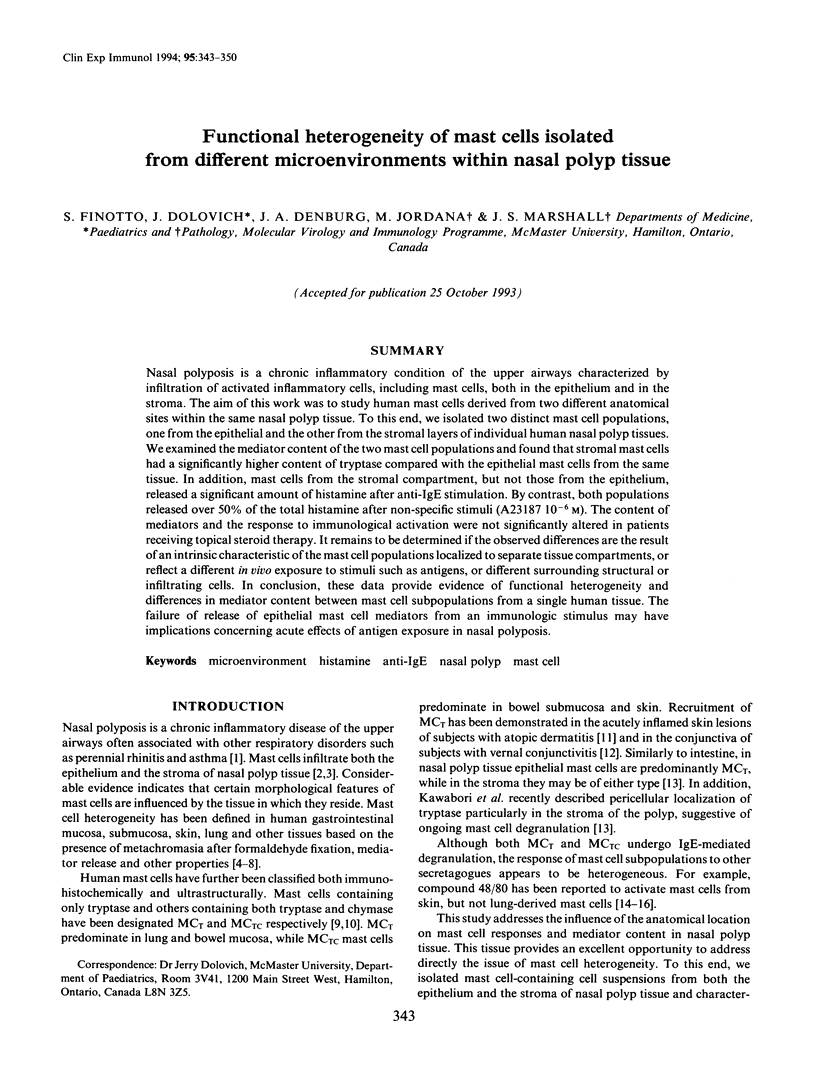
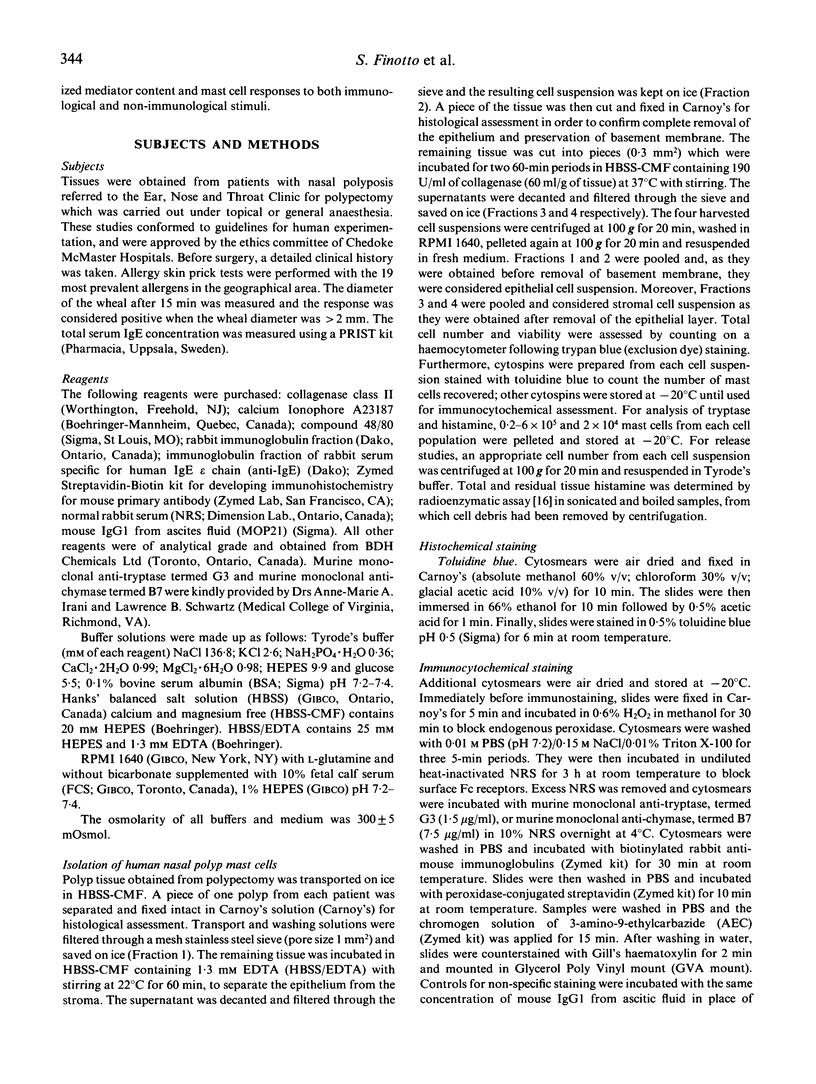
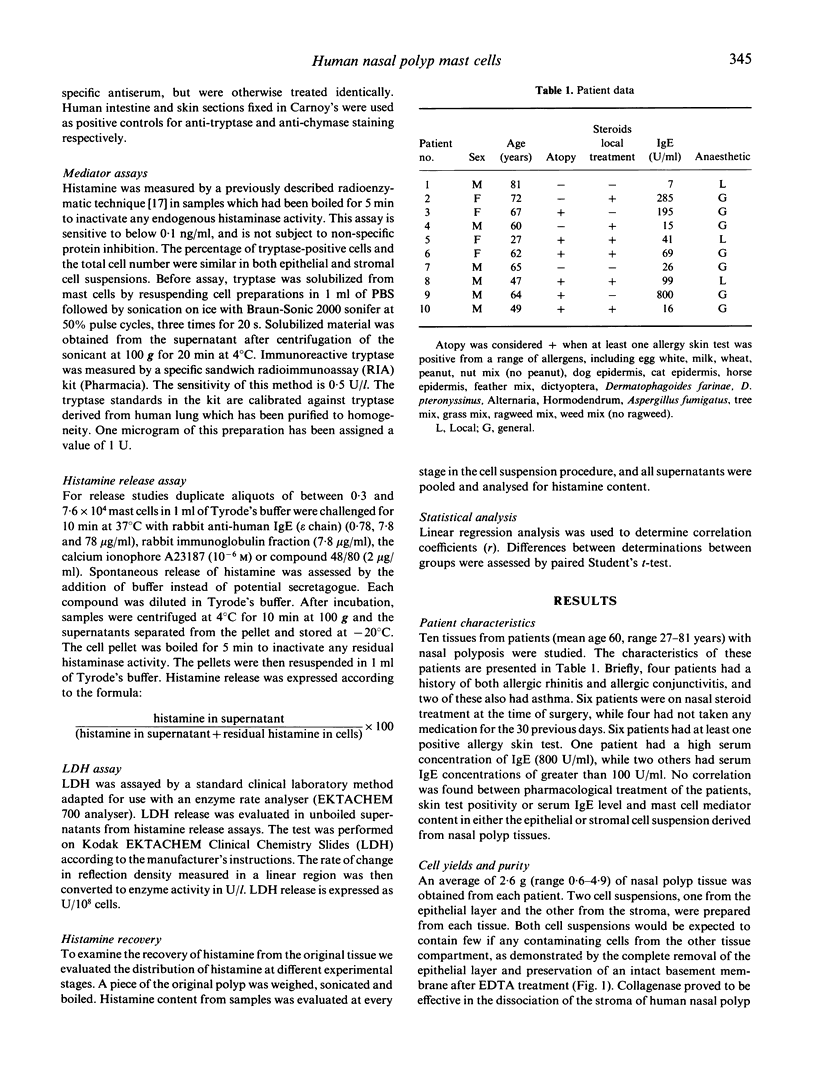
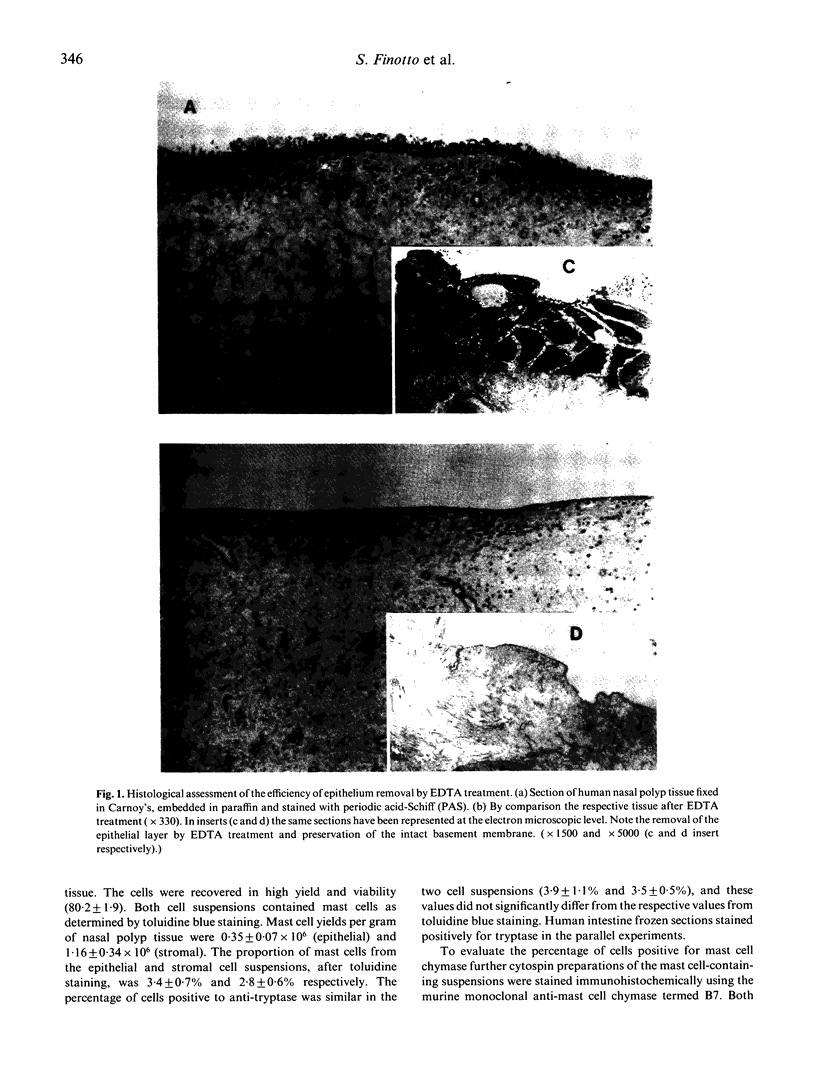
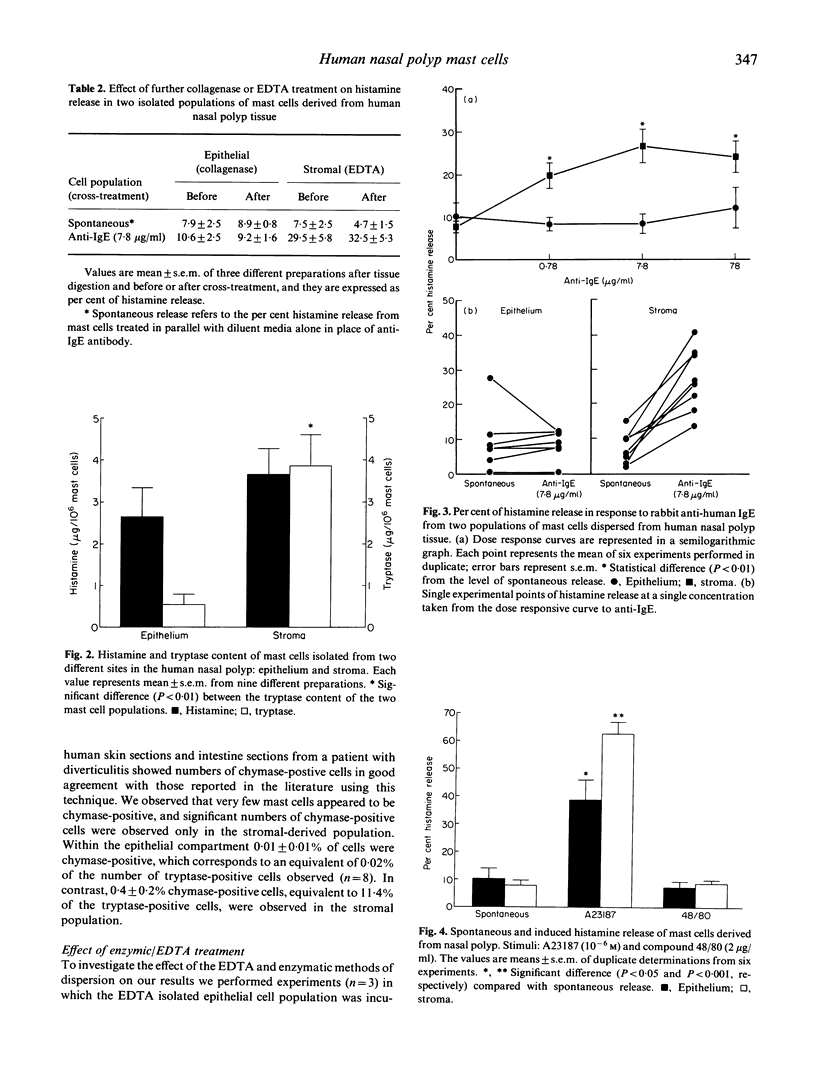
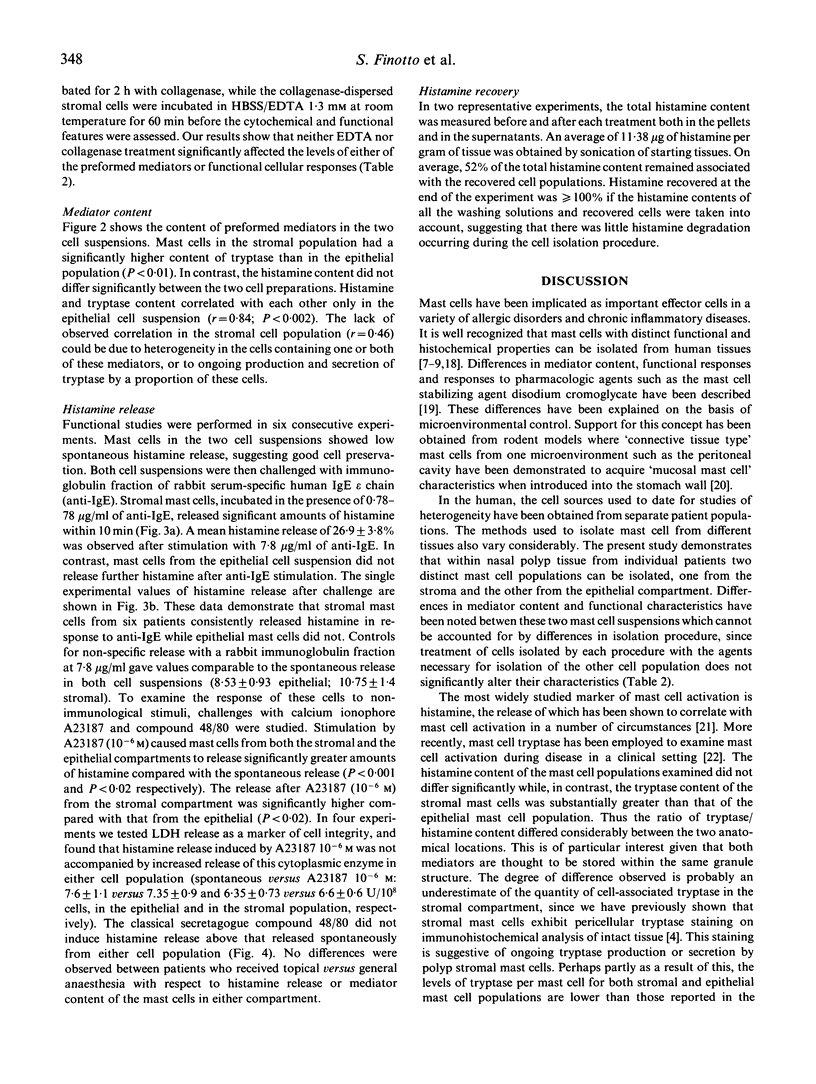
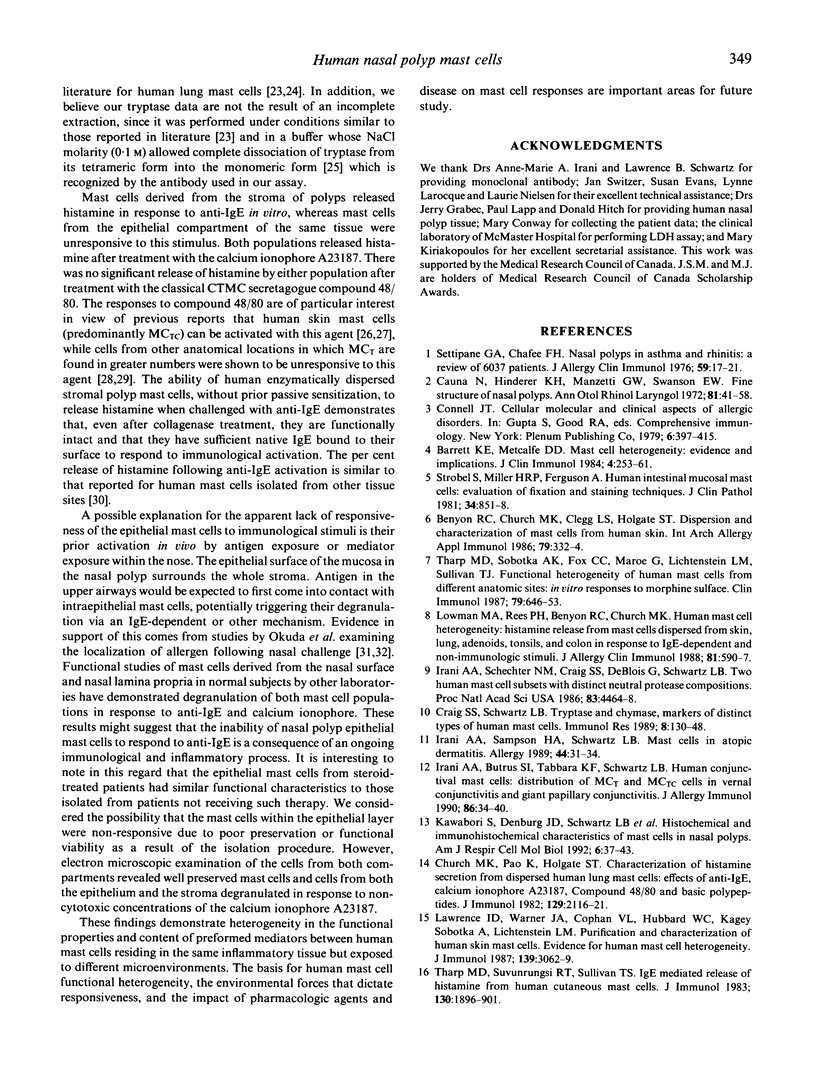
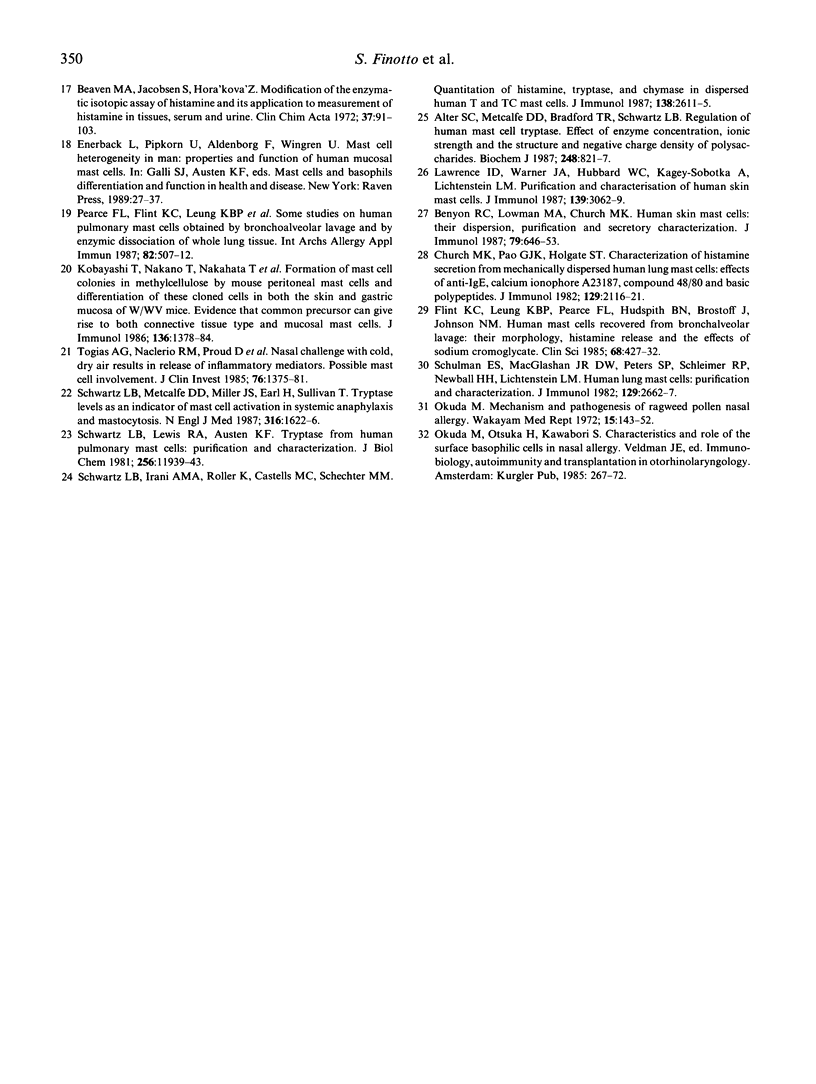
Images in this article
Selected References
These references are in PubMed. This may not be the complete list of references from this article.
- Alter S. C., Metcalfe D. D., Bradford T. R., Schwartz L. B. Regulation of human mast cell tryptase. Effects of enzyme concentration, ionic strength and the structure and negative charge density of polysaccharides. Biochem J. 1987 Dec 15;248(3):821–827. doi: 10.1042/bj2480821. [DOI] [PMC free article] [PubMed] [Google Scholar]
- Barrett K. E., Metcalfe D. D. Mast cell heterogeneity: evidence and implications. J Clin Immunol. 1984 Jul;4(4):253–261. doi: 10.1007/BF00915292. [DOI] [PubMed] [Google Scholar]
- Beaven M. A., Jacobsen S., Horáková Z. Modification of the enzymatic isotopic assay of histamine and its application to measurement of histamine in tissues, serum and urine. Clin Chim Acta. 1972 Mar;37:91–103. doi: 10.1016/0009-8981(72)90419-6. [DOI] [PubMed] [Google Scholar]
- Benyon R. C., Church M. K., Clegg L. S., Holgate S. T. Dispersion and characterisation of mast cells from human skin. Int Arch Allergy Appl Immunol. 1986;79(3):332–334. doi: 10.1159/000233996. [DOI] [PubMed] [Google Scholar]
- Cauna N., Manzetti G. W., Hinderer K. H., Swanson E. W. Fine structure of nasal polyps. Ann Otol Rhinol Laryngol. 1972 Feb;81(1):41–58. doi: 10.1177/000348947208100105. [DOI] [PubMed] [Google Scholar]
- Church M. K., Pao G. J., Holgate S. T. Characterization of histamine secretion from mechanically dispersed human lung mast cells: effects of anti-IgE, calcium ionophore A23187, compound 48/80, and basic polypeptides. J Immunol. 1982 Nov;129(5):2116–2121. [PubMed] [Google Scholar]
- Church M. K., Pao G. J., Holgate S. T. Characterization of histamine secretion from mechanically dispersed human lung mast cells: effects of anti-IgE, calcium ionophore A23187, compound 48/80, and basic polypeptides. J Immunol. 1982 Nov;129(5):2116–2121. [PubMed] [Google Scholar]
- Craig S. S., Schwartz L. B. Tryptase and chymase, markers of distinct types of human mast cells. Immunol Res. 1989;8(2):130–148. doi: 10.1007/BF02919075. [DOI] [PubMed] [Google Scholar]
- Flint K. C., Leung K. B., Pearce F. L., Hudspith B. N., Brostoff J., Johnson N. M. Human mast cells recovered by bronchoalveolar lavage: their morphology, histamine release and the effects of sodium cromoglycate. Clin Sci (Lond) 1985 Apr;68(4):427–432. doi: 10.1042/cs0680427. [DOI] [PubMed] [Google Scholar]
- Irani A. A., Schechter N. M., Craig S. S., DeBlois G., Schwartz L. B. Two types of human mast cells that have distinct neutral protease compositions. Proc Natl Acad Sci U S A. 1986 Jun;83(12):4464–4468. doi: 10.1073/pnas.83.12.4464. [DOI] [PMC free article] [PubMed] [Google Scholar]
- Irani A. M., Butrus S. I., Tabbara K. F., Schwartz L. B. Human conjunctival mast cells: distribution of MCT and MCTC in vernal conjunctivitis and giant papillary conjunctivitis. J Allergy Clin Immunol. 1990 Jul;86(1):34–40. doi: 10.1016/s0091-6749(05)80120-4. [DOI] [PubMed] [Google Scholar]
- Irani A. M., Sampson H. A., Schwartz L. B. Mast cells in atopic dermatitis. Allergy. 1989;44 (Suppl 9):31–34. [PubMed] [Google Scholar]
- Kawabori S., Denburg J. A., Schwartz L. B., Irani A. A., Wong D., Jordana G., Evans S., Dolovich J. Histochemical and immunohistochemical characteristics of mast cells in nasal polyps. Am J Respir Cell Mol Biol. 1992 Jan;6(1):37–43. doi: 10.1165/ajrcmb/6.1.37. [DOI] [PubMed] [Google Scholar]
- Kobayashi T., Nakano T., Nakahata T., Asai H., Yagi Y., Tsuji K., Komiyama A., Akabane T., Kojima S., Kitamura Y. Formation of mast cell colonies in methylcellulose by mouse peritoneal cells and differentiation of these cloned cells in both the skin and the gastric mucosa of W/Wv mice: evidence that a common precursor can give rise to both "connective tissue-type" and "mucosal" mast cells. J Immunol. 1986 Feb 15;136(4):1378–1384. [PubMed] [Google Scholar]
- Lawrence I. D., Warner J. A., Cohan V. L., Hubbard W. C., Kagey-Sobotka A., Lichtenstein L. M. Purification and characterization of human skin mast cells. Evidence for human mast cell heterogeneity. J Immunol. 1987 Nov 1;139(9):3062–3069. [PubMed] [Google Scholar]
- Lawrence I. D., Warner J. A., Cohan V. L., Hubbard W. C., Kagey-Sobotka A., Lichtenstein L. M. Purification and characterization of human skin mast cells. Evidence for human mast cell heterogeneity. J Immunol. 1987 Nov 1;139(9):3062–3069. [PubMed] [Google Scholar]
- Lowman M. A., Rees P. H., Benyon R. C., Church M. K. Human mast cell heterogeneity: histamine release from mast cells dispersed from skin, lung, adenoids, tonsils, and colon in response to IgE-dependent and nonimmunologic stimuli. J Allergy Clin Immunol. 1988 Mar;81(3):590–597. [PubMed] [Google Scholar]
- Pearce F. L., Flint K. C., Leung K. B., Hudspith B. N., Seager K., Hammond M. D., Brostoff J., Geraint-James D., Johnson N. M. Some studies on human pulmonary mast cells obtained by bronchoalveolar lavage and by enzymic dissociation of whole lung tissue. Int Arch Allergy Appl Immunol. 1987;82(3-4):507–512. doi: 10.1159/000234266. [DOI] [PubMed] [Google Scholar]
- Schulman E. S., MacGlashan D. W., Jr, Peters S. P., Schleimer R. P., Newball H. H., Lichtenstein L. M. Human lung mast cells: purification and characterization. J Immunol. 1982 Dec;129(6):2662–2667. [PubMed] [Google Scholar]
- Schwartz L. B., Irani A. M., Roller K., Castells M. C., Schechter N. M. Quantitation of histamine, tryptase, and chymase in dispersed human T and TC mast cells. J Immunol. 1987 Apr 15;138(8):2611–2615. [PubMed] [Google Scholar]
- Schwartz L. B., Lewis R. A., Austen K. F. Tryptase from human pulmonary mast cells. Purification and characterization. J Biol Chem. 1981 Nov 25;256(22):11939–11943. [PubMed] [Google Scholar]
- Schwartz L. B., Metcalfe D. D., Miller J. S., Earl H., Sullivan T. Tryptase levels as an indicator of mast-cell activation in systemic anaphylaxis and mastocytosis. N Engl J Med. 1987 Jun 25;316(26):1622–1626. doi: 10.1056/NEJM198706253162603. [DOI] [PubMed] [Google Scholar]
- Settipane G. A., Chafee F. H. Nasal polyps in asthma and rhinitis. A review of 6,037 patients. J Allergy Clin Immunol. 1977 Jan;59(1):17–21. doi: 10.1016/0091-6749(77)90171-3. [DOI] [PubMed] [Google Scholar]
- Strobel S., Miller H. R., Ferguson A. Human intestinal mucosal mast cells: evaluation of fixation and staining techniques. J Clin Pathol. 1981 Aug;34(8):851–858. doi: 10.1136/jcp.34.8.851. [DOI] [PMC free article] [PubMed] [Google Scholar]
- Tharp M. D., Kagey-Sobotka A., Fox C. C., Marone G., Lichtenstein L. M., Sullivan T. J. Functional heterogeneity of human mast cells from different anatomic sites: in vitro responses to morphine sulfate. J Allergy Clin Immunol. 1987 Apr;79(4):646–653. doi: 10.1016/s0091-6749(87)80162-8. [DOI] [PubMed] [Google Scholar]
- Tharp M. D., Suvunrungsi R. T., Sullivan T. J. IgE-mediated release of histamine from human cutaneous mast cells. J Immunol. 1983 Apr;130(4):1896–1901. [PubMed] [Google Scholar]
- Togias A. G., Naclerio R. M., Proud D., Fish J. E., Adkinson N. F., Jr, Kagey-Sobotka A., Norman P. S., Lichtenstein L. M. Nasal challenge with cold, dry air results in release of inflammatory mediators. Possible mast cell involvement. J Clin Invest. 1985 Oct;76(4):1375–1381. doi: 10.1172/JCI112113. [DOI] [PMC free article] [PubMed] [Google Scholar]



